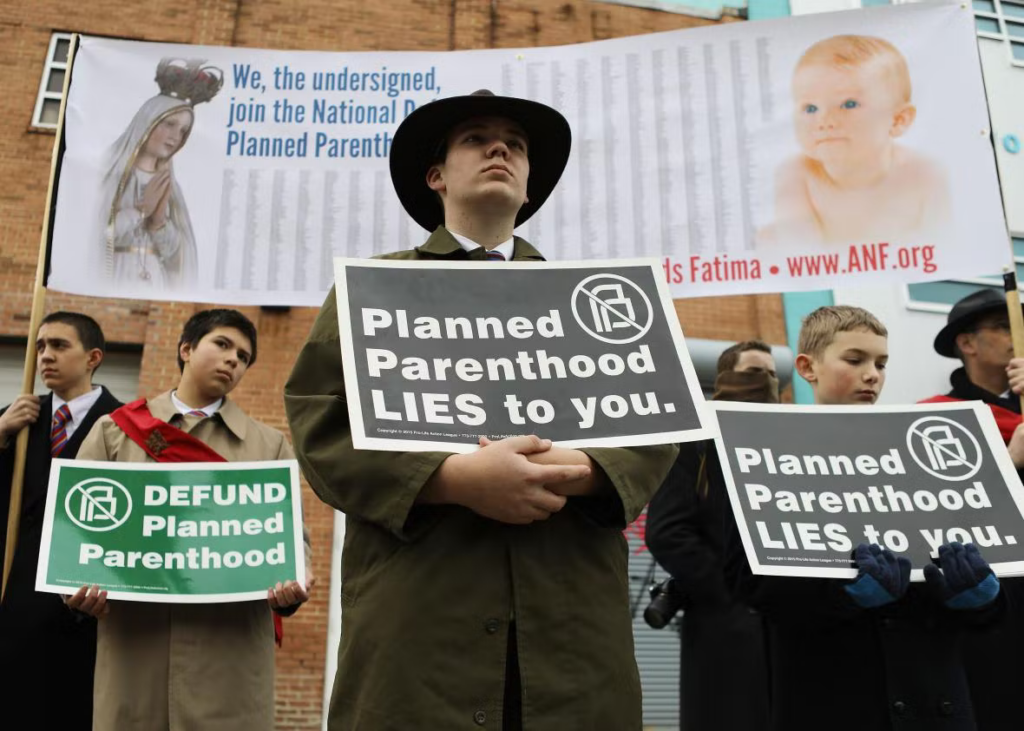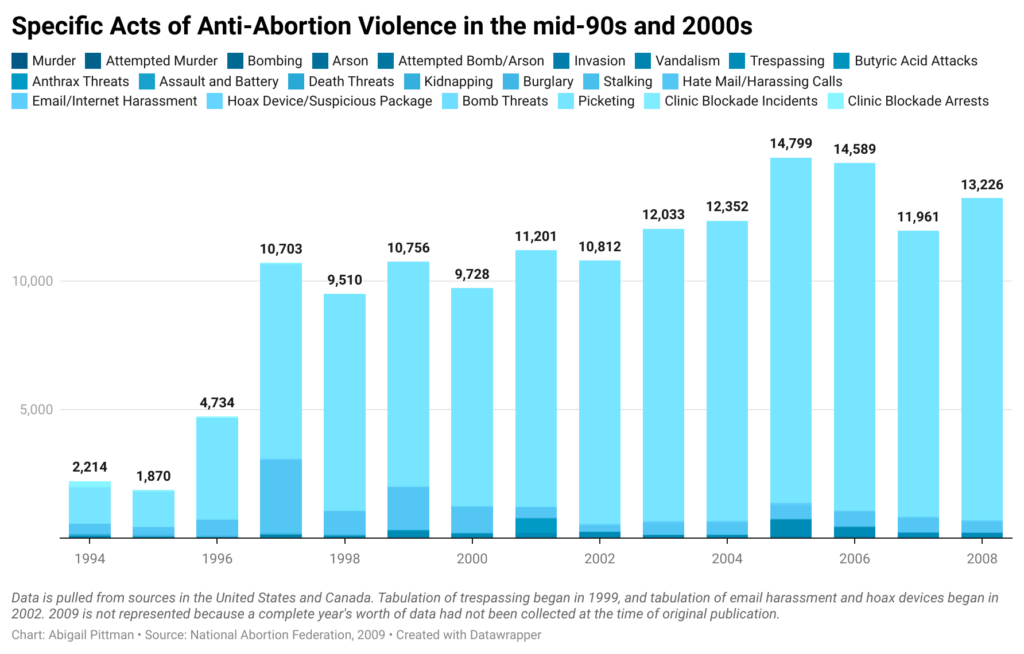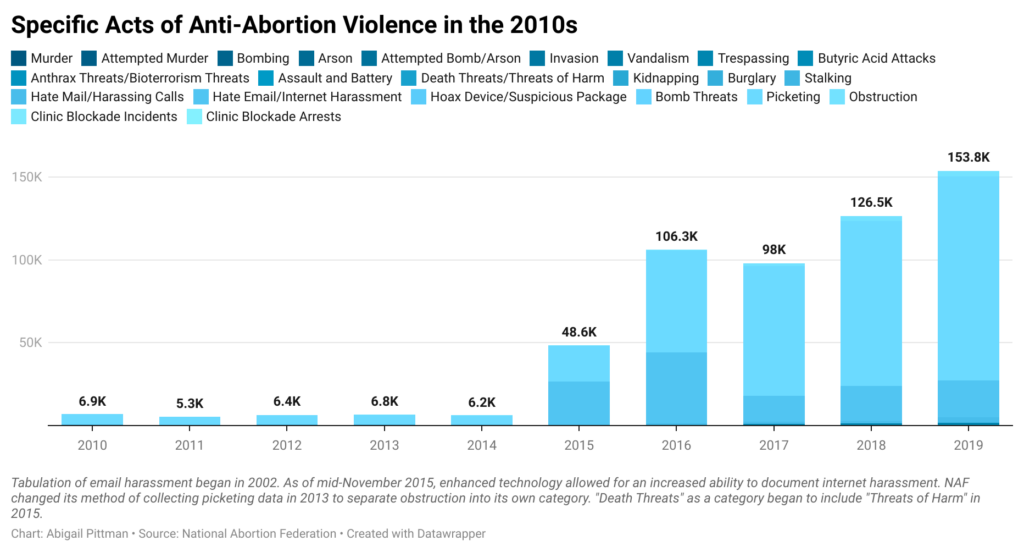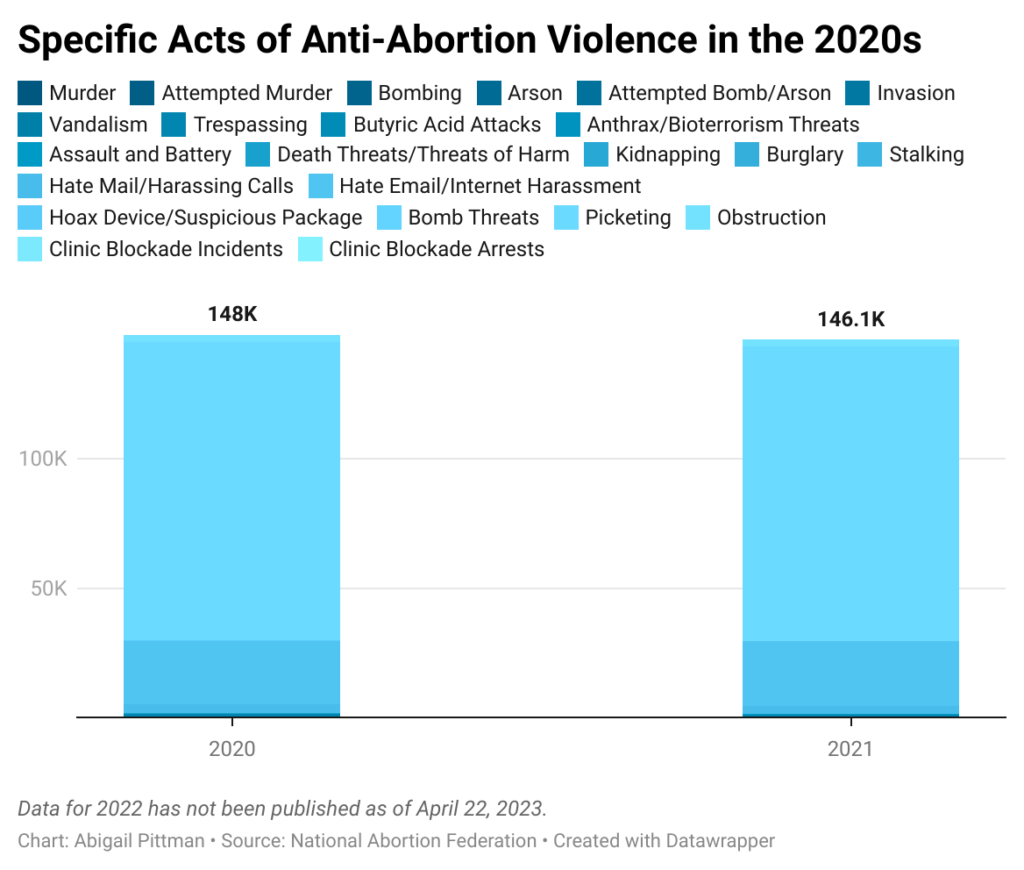
Mario Tama/Getty Images
ABSTRACT
Since the 1977 Roe v. Wade decision, anti-abortion violence has loomed around abortion providers and clinics. Protesters threaten arson, murder, bombs, or kidnappings, among others, and sometimes act on those threats–one doctor was shot in the back walking into his clinic in the 1990s. This piece examines those trends and reflects on how the knowledge of these things (or lack thereof) might tell us something about collective memory.
ANALYSIS
The recent overturn of the 1973 Roe v Wade decision may call to mind imagery of anti-abortion signage, people standing outside Planned Parenthood clinics, or extremists threatening to burn down clinics or kill the people who run them. While this may seem like a recent phenomenon–threatening and/or enacting mass violence–anti-abortion violence has existed to some extent since 1973, when Roe v. Wade was decided.
Anti-abortion violence takes many forms. While harassment is most common [6], threats or acts of arson, gun violence, or vandalism (which includes breaking things or graffiti) also occur. Harassment has many definitions, including vocal protest, photographing or videoing patients at abortion clinics, approaching patient vehicles, and recording license plates [6].
The 1980s and 90s saw a spike in anti-abortion violence (see Table 1). 1984-86, in particular, saw rises in almost every type of violence or threatened violence.
Barbara Radford was executive director of the National Abortion Federation (NAF) in 1993 and wrote an article with Federation representative Gina Shaw at that time [3]. Their writing pointed to the work of a sociologist, Dallas Blanchard, and his idea that the rise in antiabortion violence in the mid-80s was tied to discontent with Ronald Reagan’s lack of progress with antiabortion legislature.
However, the violence didn’t continue on a downward trend when Reagan left office in 1988 and was replaced by George Bush.
A New York Times article reported data from the NAF in 1993, saying that vandalism between 1991 and 1992 had “more than doubled” and that cases of arson had tripled [5].
In 1993, amidst the rise in violence, an abortion provider was murdered. Dr. David Gunn of Pensacola, FL, was shot in the back three times while walking into his clinic in March of ’93 by anti-abortion protester Michael F. Griffin [5].
It wasn’t an isolated incident. Following the murder of Dr. Gunn, a woman named Rachelle Shelley Shannon “began corresponding with Griffin while he was in prison. The man who she called “the awesomest greatest hero of our time” did nothing to dissuade her from then going out and attempting to kill a doctor in Wichita, Kansas. Her shots wounded, but did not kill, and Shannon was arrested and convicted” [1].
Another man, Paul Hill, went on to kill Dr. John Britton and James Barrett, again in Pensacola, FL, in 1994.
Following the string of murders, Congress passed the FACE Act in 1994. The FACE Act protects abortion clinics and “pro-life pregnancy counseling services” alike, pulling both under the umbrella of “reproductive health services”[2]. FACE, or the Freedom of Access to Clinic Entrances Act, “prohibits violent, threatening, damaging and obstructive conduct intended to injure, intimidate or interfere with the right to seek, obtain or provide reproductive health services” [2]. The law makes things like harming abortion clinic workers or people escorting patients a criminal offense. It also prohibits “threats of bodily harm” [2] to patients or workers, blockades, and arson [2]. The consequences are one year in prison or a fine of varying amount [2].
Additionally, anti-abortion violence like arson and gun violence at abortion clinics can fit the definition of domestic terrorism [7] given by the Federal Bureau of Investigation (FBI). Acts of domestic terrorism are “activities” “involving acts dangerous to human life that are a violation of the criminal laws of the United States or of any State; appearing to be or intended to:
- intimidate or coerce a civilian population;
- influence the policy of government by intimidation or coercion; or
- affect the conduct of a government by mass destruction, assassination, or kidnapping; and
- occurring primarily within the territorial jurisdiction of the United States.”
It is worth noting that historically, the FBI has been generally hesitant to classify acts of anti-abortion violence as domestic terrorism.
It is also worth noting that with the Dobbs v. Jackson (2022) decision, the FACE Act is no longer stable in law. On April 6, 2023, United States Congressman Chip Roy of Texas (R) announced in a press release his intent to defund the FACE Act along with 11 other members of Congress because “the law has since been weaponized by the Department of Justice to wrongly target pro-life individuals” [4].
Bringing the Past to the Present
With the onset of the Internet, harassment online and in person via picketing have moved to the forefront of anti-abortion violence (see Tables 2, 3, and 4). Numbers are incredibly higher than in the 80s, which could be attributed in part to the interconnectivity of today’s world. While the data may not show that physical/actual violence (as opposed to deterrents/harassment) are as prominent as they used to be, it’s important to recognize the role of the access to so much information that so many people have today. The Internet plays a part in how thoughts of anti-abortion violence spread today–with AI and misinformation campaigns abounding, it can be difficult to tell what’s real or if something really happened or was said by someone. Even if information is false, it can spread like wildfire and cause action in the real world.
Jump past data by clicking here!



Anti-Abortion Violence in Collective Memory
Our collective understanding of anti-abortion violence has definitely been influenced by the Internet, but it has, in my opinion, also been influenced by the taboo surrounding abortion in general. I had no idea that people had been murdered for performing abortions or that there had been so much violence ever since Roe v. Wade was passed. I assumed (rather naively, but nonetheless) that the major feeling would have been to rejoice in the first years after the decision. Roe v. Wade isn’t something I recall discussing in school beyond the fact that it happened, and my guess is that many people have had similar experiences.
It’s indicative of both the processual and partial aspects of collective memory. Over the years, Roe v. Wade was simplified and the meaning changed as a generation was born that had not known life without it. It was partial because some things, like the murder of Dr. Gunn, were left out of mainstream memory (as were things like the Jane Collective).
Perhaps people avoided talking about it to try to ignore that it had happened, a sort of abstract designation (designation in this instance is used to mean “the marking of a site that simply denotes that something happened there”, as opposed to sanctifying it or obliterating it from memory).
Regardless, Dobbs v. Jackson has pulled Roe v. Wade and all that came after to the forefront of collective memory.
Written by Abigail Pittman.
SOURCES
[1] “Dr. David Gunn Is Murdered by Anti-Abortion Activist.” History.com, A&E Television Networks, 8 Mar. 2021, https://www.history.com/this-day-in-history/dr-david-gunn-is-murdered-by-anti-abortion-activist.
[2] “Protecting Patients and Health Care Providers.” The United States Department of Justice, The United States Department of Justice, 15 Sept. 2022, https://www.justice.gov/crt/protecting-patients-and-health-care-providers.
[3] Radford, Barbara, and Gina Shaw. “Antiabortion Violence: Causes and Effects.” Women’s Health Issues, vol. 3, no. 3, 1993, pp. 144–151., https://doi.org/10.1016/s1049-3867(05)80248-8.
[4] “Rep. Chip Roy Leads Effort to Defund Face Act.” Representative Chip Roy, Representative Chip Roy, 6 Apr. 2023, https://roy.house.gov/media/press-releases/rep-chip-roy-leads-effort-defund-face-act.
[5] Rohter, Larry. “Doctor Is Slain During Protest Over Abortions.” The New York Times, The New York Times, 11 Mar. 1993, https://www.nytimes.com/1993/03/11/us/doctor-is-slain-during-protest-over-abortions.html.
[6] Table 2 Analysis. Russo, Jennefer A., et al. “Antiabortion Violence in the United States.” Contraception, vol. 86, no. 5, Nov. 2012, pp. 562–566., https://doi.org/10.1016/j.contraception.2012.02.011.
[7] “Strategic Intelligence Assessment and Data on Domestic Terrorism.” Strategic Intelligence Assessment and Data on Domestic Terrorism, Federal Bureau of Investigation, Department of Homeland Security, Oct. 2022, https://www.dhs.gov/publication/strategic-intelligence-assessment-and-data-domestic-terrorism.
[8] Table 1: Wilson, Michele, and John Lynxwiler. “Abortion Clinic Violence as Terrorism.” Terrorism, vol. 11, no. 4, 1988, pp. 263–273., https://doi.org/10.1080/10576108808435717.
[9] Table 2: “NAF Violence and Disruption Statistics – National Abortion Federation (90s).” National Abortion Federation, National Abortion Federation, https://www.prochoice.org/pubs_research/publications/downloads/about_abortion/violence_stats.pdf.
[10] Table 3: “Violence & Disruption Statistics Overview – National Abortion Federation (2010s).” National Abortion Federation, National Abortion Federation, https://prochoice.org/wp-content/uploads/2021_NAF_VD_Stats_Final.pdf.
[11] Table 4: “Violence & Disruption Statistics Overview – National Abortion Federation (2020s).” National Abortion Federation, National Abortion Federation, https://prochoice.org/wp-content/uploads/2021_NAF_VD_Stats_Final.pdf.
Additional Reading + Resources
https://pubmed.ncbi.nlm.nih.gov/22464412/ Antiabortion violence in the US (2012)
https://pubmed.ncbi.nlm.nih.gov/8274869/ Antiabortion violence: causes and effects (1993)
https://pubmed.ncbi.nlm.nih.gov/1957842/ An epidemic of anti-abortion violence in the US (1991) (can’t read, only cite)
https://www.cbsnews.com/news/violence-against-abortion-clinics-like-planned-parenthood-hit-a-record-high-last-year-doctors-say-its-getting-worse/ >>> Violence against abortion clinics hit a record high last year. Doctors say it’s getting worse. (2019)
https://www.justice.gov/crt/recent-cases-violence-against-reproductive-health-care-providers >>> RECENT CASES ON VIOLENCE AGAINST REPRODUCTIVE HEALTH CARE PROVIDERS (2010-2022)
https://www.npr.org/sections/health-shots/2023/04/07/1168547810/clinics-offering-abortions-face-a-rise-in-threats-violence-and-legal-battles >>> Clinics offering abortions face a rise in threats, violence and legal battles (2023)
https://www.chicagotribune.com/news/breaking/ct-violence-abortion-clinics-pregnancy-centers-20230205-6h6lfk32jncqnowxuvayb33yea-story.html >>> Arson. Vandalism. Threats. Abortion clinics, abortion opponents face violence after the fall of Roe. (Feb 2023)
https://www.prochoiceamerica.org/wp-content/uploads/2022/11/NARAL-Nov-2022-Deck-Rev-E.pdf
https://www.ojp.gov/ncjrs/virtual-library/abstracts/anti-abortion-violence-movement-increases
https://www.ojp.gov/ncjrs/virtual-library/abstracts/abortion-clinic-violence-terrorism
https://ethics.ny.gov/system/files/documents/2018/01/naral-application-posting.pdf